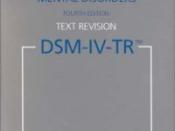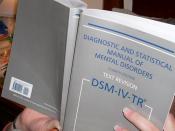"The Diagnostic and Statistical Manual of Mental Disorders", better know as the DSM series, categorizes many psychiatric diagnoses. This manual is widely used by clinicians today. When making a diagnosis, clinicians are required to evaluate a patient's condition on five different axes. The first axes deals with clinical syndromes such as anxiety or mood disorders. Depression and schizophrenia are both axes I diagnosis. Axes II covers mental retardation and personality disorders. Mental retardation is usually apparent in early childhood. Individuals with personality disorders usually display a continued rigid pattern of inner experience and outward behavior. Next, Axes III deals with physical conditions that play a role in the development of Axes I and Axes II disorders. Axes III focuses on relevant medical conditions that a patient is suffering from. Axes IV concentrates on special psychological or environmental problems a patient is facing. This can include events such as starting a new job, starting school, or unemployment.
Finally, Axes V deals with the patient's highest level of functioning. The clinician rates the patient's level of functioning both at the present time and the highest level within the previous year. After addressing all five axes, the clinician can offer a complete diagnosis of the patient's disorder.
In order to analyze the effectiveness of a diagnosis method, one must examine the reliability and validity of the assessment, diagnosis, and treatment. To be reliable, many different clinicians must be able to agree and come to the same diagnosis for the same patient. As the DSM series has been revised over the past 50 years, it has become very reliable. DSM-IV also has a strong validity. The information that its diagnosis categories provide is extremely accurate. By running many research studies, the frames of DSM-IV have been able to ensure the reliability and...


